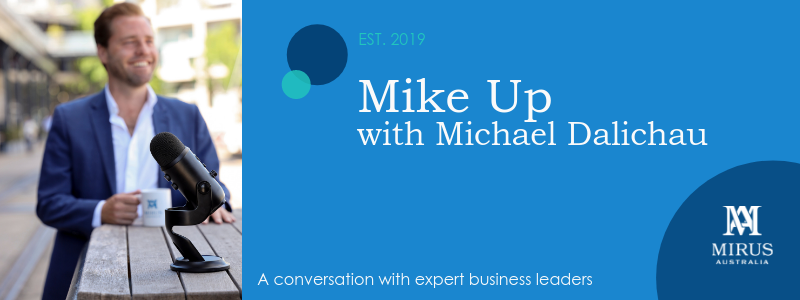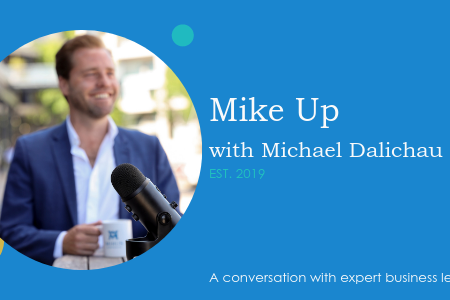How I met your customer (Part 1)
March 5, 2019 | Aged Care Management

Part 1: What is Pricing
Please join Mike Up with Michael Dalichau. A conversation with expert business leaders. Michael has a conversation with leaders via his podcast, providing another channel for connection during the complex changes facing the Australian Aged Care Industry. Michael believes the inner pull to change and the external need for change are linked. Based on the data we analyse at Mirus Australia and meetings with business leaders, it’s our experience that many are feeling overwhelmed by the noise and current demands across the entire aged care system. Mike Up provides continued education and bite-sized information that is easy to digest and challenges people to keep asking questions, discover more and consider what needs to be changed.
Michael has a conversation with Chris Petzoldt, Partner & Managing Director Oceania, Simon-Kucher & Partners. Simon–Kucher is the globally leading top-line consulting firm. They help clients grow their revenues and profits by optimising their strategy, offer, pricing, and sales. Actionable recommendations and measurable KPI improvements are the results.
What is pricing?
“This is a question we hear often. Many people think pricing is just the sticker on the product, a room or the yoghurt on the shelf, but there is a lot more to it than that.
If you want to get your pricing strategy right, firstly you must have the right product that fulfils customer needs and optimally fulfils customer needs better that your competitors. You need to be able to capture the value you offer via your products and services to customers.
I often ask do you understand the value of what you offer? A customer will pay the price of the value you offer. In my experience, people look at only the cost or what the competition is charging to find what prices should be. Unless you really understand the customer and adjust the offer to suit the customer better than anyone else, it can be challenging to optimise price.”
In this podcast, we are discussing the mechanics of pricing. What do you need in your organisation to understand pricing?
“To understand your current capability, start reviewing the following with regards to your offer:
- What is your offer?
- Do you understand and know your customer and the customer segments?
- How do they differ with regards to their needs and their decision making and willingness to pay?
- How complex is your offer? For example, do you have too many variations of rooms or add on services?
- Is your offer too simple? And therefore, you are not fulfilling the various needs
- How easy is it for customers to decide?
- How many steps to people have to take to make a decision?
Review the following with regards to your pricing strategy:
- Review benchmarks and what your competitors are charging
- Review reimbursements available from government funding?
- What do your customers perceive as value?
- Are your Terms & Conditions clearly defined?”
How important is data and the interpretation of data?
“Data can be captured in a structured way and sometimes less structured. A great place to start your assessment is actual transactional data or the up-sell of products. What is the average spend for example? But you can’t analyse everything with data. Certain ideas you may have to provide value, may not appear in the data because you haven’t done it yet!
Unless you engage with your customers, the market and think out of the box and find out what they want and what they want in the future, how can you move forward? Of course, the sentence “this is the way we have always done it” is the worst when it comes to strategic thinking because you may have done it wrong all the time!”
What examples can you provide where customers have applied this thinking well?
“Some organisations ‘burn their fingers’ when they ask the question ‘what do you want?’ It’s hard for people to say what they want and so they say “everything”! And how much are you willing to pay? And they answer, “not much or nothing”!
You have to find the right customer methodology when it comes to research. For example, if you have different rooms, with different prices and different service levels, you may ask the question ‘what would you pick?’ and you provide a choice with different options. So instead of a ‘take it or leave it’ approach, in a simulated research environment you are trying to discover, what drove the decision? Was it the price, the size, the venue, location, the view?
We apply this thinking to new residential apartments. The goal is to identify what is the value of certain features e.g. should we add 3 bathrooms in a 3-bedroom apartment or only 2 and what is the willingness to pay and not just for the cost for the additional bathroom.
Unless people are willing to pay more for the cost of putting the 3rd bathroom in you don’t. You need that depth of understanding of the cost and willingness to pay for making decisions about certain features.”
What are the different models you can apply to price?
“If you are in a free market, there are an infinite number of model pricing models you can apply. In a market that is regulated, you can consider applying different pricing models to the unregulated parts or review how do you charge for additional services? Airlines, for example, a high percentage of profit margin is from additional extras, not the actual base fare. In the Machinery business 20 – 30% of the fees are from the additional services, not the actual core product.
You need to develop a service portfolio that is attractive and appealing to customers. It could be bundled into the core offer or a good, better, best room and certain features are included. Or you have special add on services that people could book later on.”
Where have you seen assumptions about the customer managed well?
“We recently worked for a global fitness company and we originally were trying to help them with incentives to sign up certain types of customers. During the project, it turned out that actual refurbishment of the facilities like the showers and the changerooms had a much higher value perception than an incentive offer. Ask the question, what would an efficient marketing mix look like and where do you spend your money? Is it the facility, the price or emotional reasons? Review next to each other and not in isolation or you may miss the actual way to improve the value.”
Thank you, Chris. What are your key takeaways from this podcast?
- Understand what your customers need
- Understand how you can fulfil those needs
- Understand how you can full those needs better than your competitors
Charge for the value you create and then you also have a competitive advantage.”
Part 2. How I met your customer
Chris Petzoldt is Partner & Managing Director Oceania at Simon-Kucher & Partners. Chris has more than 18 years of global consulting experience and opened Simon-Kucher’s Australian operations in 2011. He primarily works in the areas of monetisation strategies (offer design, pricing, sales) for tech, software, telecoms, and media clients. He has conducted more than 150 projects in that space across Australia, New Zealand, Europe, Asia, Middle East, Oceania, and South America. Clients include large listed entities, unicorns as well as upcoming Internet startups. Chris is a regular presenter at executive conferences around the world like Marcus Evans, NeoEdge, Salvo, GSMA Asia, Zuora Subscribed and others. Chris studied business administration at the University of Kiel and at the School of Business and Commercial Law Gothenburg, Sweden. He majored in Innovation Management and Marketing. For more information about Simon-Kucher, please click here. To connect with Chris on LinkedIn, please click here.


